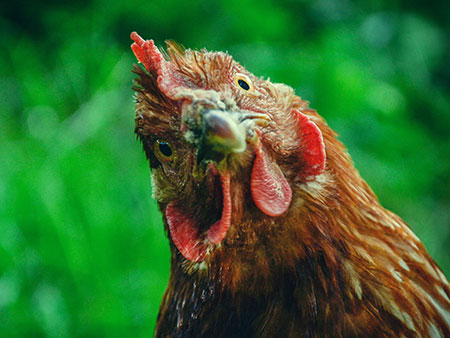To continue our discussion of the role of protein in poultry feed I would like to cover the topic of animal vs. plant protein. Whenever this topic is brought up it seems that people either love animal protein or are the opposite and are afraid of having it in their feed. Many old-time poultry breeders will swear that is absolutely essential and that birds need it. At the same time, a lot of folks do not like having an animal by-product in their feed for fear of disease transmission or they don’t like the thought of their chickens eating a mysterious animal by-product. Front View Feeds does use animal protein in most of our diets and I would like to explain the reasons why and present the facts about animal and plant protein.

First of all, let’s look at the natural diet of domestic poultry.
Chickens, ducks, turkeys, guinea fowl, and upland game birds are very well known for being omnivores. They mostly eat grains, seeds, and other plant materials. However, when given the chance they will eat numerous beetles, worms, grasshoppers, slugs, snails, etc. And I think most poultry people have either witnessed first-hand or heard stories of chickens, ducks, or guineas eating mice, frogs, snakes, and other small vertebrate animals. So, we know it is not out of the question for our domestic poultry to eat animal protein in their natural state. This indicates that those animals can utilize animal protein and appear to benefit from it. But are their other suitable protein sources? Does this mean they absolutely have to have animal protein?
Let’s define what animal and plant protein sources are.
Animal proteins are made from the muscle, fat, and bone residues that are otherwise unfit for human consumption. This waste includes things like meat trimmings, saw dust, miss-cut meat, etc. Sometimes, like in the case with fish meal, it utilizes oily fish species that are not used for human consumption.
Common animal protein by-products include:
- Pork Meat and Bone Meal
- Ruminant Meat and Bone Meal (from cattle or sheep)
- Blood Meal
- Fish Meal
- Poultry by-product Meal
Plant protein sources are derived from oil seed or some other type of grain processing and are also considered a by-product.
Typical plant protein sources include:
- Soybean Meal
- Cottonseed Meal
- Distiller’s Dried Grains with Solubles (DDGS)
- Canola Meal
- Peanut Meal
- Corn Gluten Meal
Most animal protein sources run anywhere from 50-65% crude protein and depending on the exact product may also have some amount of fat, calcium, and phosphorus. While plant proteins typically run anywhere from 35-48% crude protein usually with little fat and depending on the product may or may not have an appreciable amount of crude fiber.
So what are the advantages of using one or the other? Both sources have their place in making poultry diets. But let’s highlight a few of the advantages and disadvantages of each:
Animal Proteins
Advantages
Disadvantages
Plant Proteins
Advantages
Disadvantages
As you can see, both sources have their advantages and disadvantages. There is not one that is inherently better than the other for that reason. Both are essential ingredients to use in a good poultry diet. If you refer back to the previous blog post about amino acids, recall that amino acids are the real reason to include protein in a diet. This fact needs to be remembered when formulating any diet and is much more important than whether it comes from a plant or animal.
If we look at most animal protein sources we find that they are higher in amino acids and contain a more appropriate balance of lysine, methionine, cysteine, threonine, and other essential amino acids compared to plant sources. Furthermore, the digestibility of those amino acids is higher than when compared to amino acids found in plant sources.
In addition to being high in amino acids, animal protein sources are usually high in available minerals like calcium and phosphorus. This is a major benefit of animal by-products and often times their use can eliminate the use of other phosphorus sources such as dicalcium phosphate. This has very good implications for your flock, because birds need phosphorus to develop a healthy skeletal system and by having a highly digestible source they can get what they need. Moreover, animal protein products often contain fat which is needed to provide your birds with their fatty acid requirement and is a great energy source.
This is not to say that plant protein is completely indigestible.
It is digestible, but it is up to the nutritionist to know how much of those amino acids are available and formulate the diets accordingly so as to not become deficient. By knowing this information about the ingredients being used, plant protein can be used effectively. Plant protein is also widely available and is much cheaper than animal protein sources. There are also no legal restrictions on the use of plant protein sources which makes it easier for mills to handle.
As good as animal protein sources are, they do have some major drawbacks. As we mentioned in the list of disadvantages of animal proteins, these ingredients should only be used at a low rate. For example, if too much fish meal is used in a diet it can have negative impacts on bird health. Poorly processed fish meal can cause gizzard erosion, where the lining of the gizzard hemorrhages and in severe cases can slough off. Furthermore, taint of meat and eggs can happen with poorly processed fish meal if there is too much in the diet. Again, I would like to emphasize that fish meal is not inherently dangerous to use, it just has to be processed properly and used at a low level to be beneficial. Likewise, studies have shown that inclusion rates of much more than 10% of pork meat and bone meal in the diet does not produce the desired positive impacts on growth than when lower levels are used. This is the reason why Front View does not put more than 10% of pork meat and bone meal in any of our diets.
Historically, before we understood much about amino acid balancing and digestibility, nutritionist often thought it was essential to use animal protein in poultry feed simply because they saw better results with it. This is why a lot of “old timers” will say that it is absolutely essential to have animal protein in poultry feeds. Thanks to research we now know that this is not the case and we have since developed other methods of getting amino acids to our birds while using plant proteins as well as animal proteins.
So is there a risk of disease transmission when using animal by-products in poultry feed?
This seems to be a big reason that some people are afraid to use animal by-products in their poultry feed. After all, it was contaminated animal by-product that lead to the massive outbreak of mad cow disease in the UK in the early 2000’s which resulted in the death of hundreds of thousands of otherwise healthy cattle and sheep.
But to answer the above question; no, there is no risk of transmitting disease by using animal by-products in poultry feed. Animal by-products that are intended for use in feed undergo very strict and highly regulated processes to render it safe. They go through a cooking process, usually under pressure, to kill any pathogens that may be present.
Furthermore, the general rule is to not feed a species by-product to that same species. Most diseases are very host specific so if a swine pathogen were to somehow contaminate our pork meat and bone meal, the odds of it having any impact on poultry would be very low.
So to summarize; the argument of plant protein vs. animal protein is really a moot argument. It is the amino acid composition of the final feed that is important. At Front View, we believe that the best poultry feed is made from a combination of plant proteins, animal proteins, and synthetic amino acids (more on this later). This combination of amino acid sources gives us a final product that is highly digestible and has the correct amount and ratio of amino acids.
